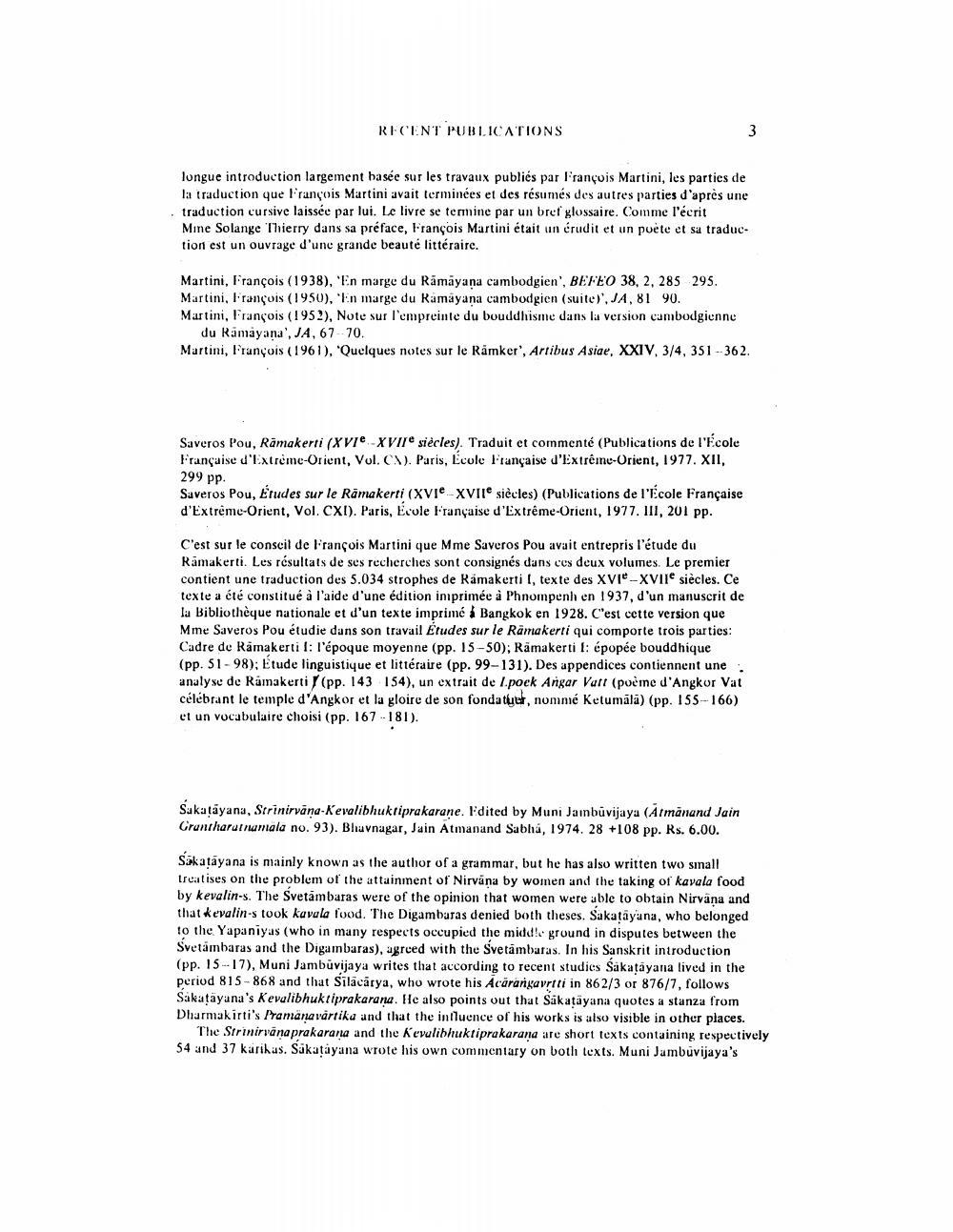Book Title: Recent Publications Author(s): Publisher: View full book textPage 1
________________ RECENT PUBLICATIONS longue introduction largement basee sur les travaux publies par Francois Martini, les parties de la traduction que l'rancois Martini avait terminees et des resumes des autres parties d'apres une traduction cursive laissee par lui. Le livre se termine par un bref glossaire. Comme l'ecrit Mine Solange Thierry dans sa preface, Francois Martini etait un erudit et un poete et sa traduction est un ouvrage d'une grande beaute litteraire. Martini, Francois (1938), 'En marge du Ramayana cambodgien', BEFEO 38, 2, 285 295. Martini, l'rancois (1950), En marge du Ramayana cambodgien (suite), JA, 81 90. Martini, Francois (1952), Note sur l'empreinte du bouddhisme dans la version cambodgienne du Ramayana', JA, 67.70. Martini, Francois (1961), 'Quelques notes sur le Ramker', Artibus Asiae, XXIV, 3/4, 351 -- 362. Saveros Pou, Ramakerti (XVI-XVIIe siecles). Traduit et commente (Publications de l'ecole Francaise d'Extreme-Orient, Vol. CX). Paris, Lcole francaise d'Extreme-Orient, 1977. XII, 299 pp. Saveros Pou, Etudes sur le Ramakerti (XVIe-XVIIe siecles) (Publications de l'Ecole Francaise d'Extreme-Orient, Vol. CXI). Paris, Ecole Francaise d'Extreme-Orient, 1977. III, 201 pp. C'est sur le conscil de Francois Martini que Mme Saveros Pou avait entrepris l'etude du Ramakerti. Les resultats de ses recherches sont consignes dans ces deux volumes. Le premier contient une traduction des 5.034 strophes de Ramakerti I, texte des XVIe-XVIIe siecles. Ce texte a ete constitue a l'aide d'une edition inprimee a Phnompenho en 1937, d'un manuscrit de la Bibliotheque nationale et d'un texte imprime a Bangkok en 1928. C'est cette version que Mme Saveros Pou etudie dans son travail Etudes sur le Ramakerti qui comporte trois parties: Cadre de Ramakertil: l'epoque moyenne (pp. 15-50); Ramakerti I: epopee bouddhique (pp. 51-98); Etude linguistique et litteraire (pp. 99-131). Des appendices contiennent une :: analyse de Ramakerti (pp. 143 154), un extrait de l.pock Angar Vatt (poeme d'Angkor Vat celebrant le temple d'Angkor et la gloire de son fondatur, nomme Ketumala) (pp. 155-166) et un vocabulaire choisi (pp. 167 - 181). Sukatayana, Sirinirvana-Kevalibhuktiprakarane. Edited by Muni Jainbuvijaya (Atmanand Jain Grantharathamala no. 93). Bhavnagar, Jain Atmanand Sabha, 1974. 28 +108 pp. Rs. 6.00. Sakataya na is mainly known as the author of a grammar, but he has also written two sinall treatises on the problem of the attainment of Nirvana by women and the taking of kavala food by kevalin-s. The Svetambaras were of the opinion that women were able to obtain Nirvana and that kevalin-s took kavala food. The Digambaras denied both theses. Sakatayana, who belonged to the. Yapaniyas (who in many respects occupied the middle ground in disputes between the Svetambaras and the Digambaras), agreed with the Svetambaras. In his Sanskrit introduction (pp. 15-17), Muni Jambuvijaya writes that according to recent studies Sakatayania lived in the period 815-868 and that Silacarya, who wrote his Acarangavrtti in 862/3 or 876/7, follows Sakatayana's Kevalibhuktiprakarana. He also points out that Sakatayana quotes a stanza from Dharmakirti's Pramana vartika and that the intluence of his works is also visible in other places. The Strinirvana prakarana and the Kevalibhuktiprakarana are short texts containing respectively 54 and 37 kurikas. Sakatayana wrote his own commentary on both texts. Muni Jambuvijaya'sPage Navigation
1 2 3 4
